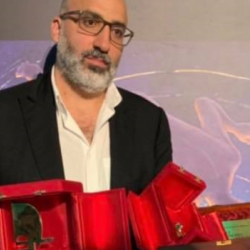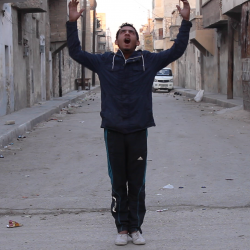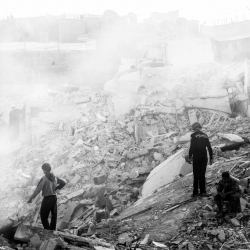12/12/2016
Author: Doha Hassan
A girl in a white gown. We don’t see her face. On the bride’s right side stands another girl pinning her hair. Another pair of hands: one hand reaches out while the other holds the tip of the bride’s hair. In their midst there is an ordinary guy, probably in his forties, holding the back zipper of the dress. The closest character is indistinct; she, too, is wearing a white gown. We see her brown hair lock, her hands, and the white gown. This looks like an ordinary picture taken minutes before a wedding.
This picture circulated in western and Arab mainstream and social media with the headline “Aleppo tailor rescues Canadian bride from wardrobe malfunction”. Lindsay Coulter’s picture received more than 13 thousand likes, 6 thousand shares, and hundreds of comments on her Facebook page.
The Practice of Refyujee Sewing
In 2009, a similar incident took place in a Damascus neighborhood. A girl is in a white wedding gown as her family gets ready for the wedding. Everybody is ecstatic. The mother of the bride approaches her daughter to zip the gown to no avail. Soon after, everybody learns about the zipper mishap. The bride’s aunt calmly takes out a needle and a white soft thread and skillfully fixes the zipper. The bride walks out the door to the car that will take her to where she will celebrate her special day.
The practice of sewing is about making garments out of stitching cotton, leather, fur, and other fibrous material using a needle and a thread. Sewing dates back to the stone ages (3000 BC). Textile flourished prior to tailoring but later depended on it, all according to Wikipedia.
It is clear, then, that the practice of sewing is not new. And since it was naturally invented by humans, the existence of tailors is no rare occurrence. But the appearance of a Syrian tailor in Canada is a grand event these days, so is the fact that he sews. There is considerable difference, it seems, between Syrian tailors and Syrian tailors who are refugees.
Syrian refugees became a phenomenon when Syrians began seeking refuge; from the moment they fled their war-torn country seeking asylum elsewhere. This is how the plight of displaced people was turned into what may be called today “refyujee brand”, where the trials of the refugees’ life are commodified for world consumption. Refyujee products are promoted in events, activities, and campaigns by organizations, institutions, traditional and social media with different headlines and slogans: “Syrian refugee cuisine”; “Syrian refugee Festival”; “Refyujees welkam”; “Refugee writers in exile”; “Syrian refugee shawarma”; “Conference on inter-refugee dialogue”.
Meanwhile, articles and reports in papers and websites are titled “Refugee hands in 150 thousand Euros found in wardrobe”; “Syrian refugee girl receives 9 offers from German universities”; “Syrian refugee crowned Wine Queen in Germany”; “Refugee mechanic opens business in South Korea”; “Syrian refugee success story in Sweden”; “Syrian refugee invents mousetrap”; “Watch: Syrian refugee makes his first porno”.
Newfound friends may have missed the humanity of refugees as well as their history, culture, economy—that at one point they were individuals, normally going about their lives somewhere else, as laborers, farmers, students, professionals with various expertise, employers, real estate owners, tenants; that they may have been humans, having gone through all life cycles, too. They may have missed the fact that refugees did not come from vacuum. Hannah Arendt writes in “We Refugees”: “Before this war broke out we were, even more, sensitive about being called refugees. We did our best to prove to other people that we were just ordinary immigrants”.
Refyujee Integration
I get to a cafe to see two friends. My phone rings; I put it aside. I greet them. My friend’s phone rings; he, too, ignores it. A few minutes later, our friend’s phone rings; she answers. She seems anxious. I glance at my phone, so did my friend: messages from friends in Munich telling us that someone shot civilians in the street. The first question the three of us ask: “Where’s the shooter from?” and then we anxiously add: “With any luck, he’s not Syrian…”; “If he turns out to be Syrian, the situation of Syrian refugees will deteriorate…”. We reach out for our phones and begin investigating the details of the terrorist attack until we come across the following: “The gunman is originally from Iran, aged…”. We stop reading and put our phones aside. We exhale. This piece of news was enough to exonerate us, we Syrian refugees. We go home and follow the details of the attack, as anyone else would—anyone who rejects the killing of civilians.
In hindsight, our anxiety was understandable, especially in the aftermath of attacks such as those of Paris and the consequences they had. Such incidents reveal numerous, contradictory, similar yet changing facts; adding or omitting details is enough to transform public impressions and reactions: “Syrian refugee kills his wife and strangles his two daughters”; “In pictures: Syrian refugee rapes a Swiss student”; “Syrian refugees committed 6 thousand crimes since the beginning of the crisis”.
It seems as though such pictures settle easily in the public imaginary that quickly accepts them as true and amplifies their meaning, as it worries about their widespread appeal. It is as though there are no clear principles that govern people’s reactions, as though people quickly swing between two poles depending on the influence of the inciting party in a particular moment.
We may argue, then, that refugees constantly feel under surveillance by their hosts. Learning the host’s language is the first and immediate mission that refugees take on, those same refugees burdened by psychological and physical traumas and their enduring losses back home. They earn their first medal as they complete the first phase of integration in the local community that gave them shelter. The process is not only about rewards, but punishment, too. The implementation of either depends, like in military school, on the principle of individual reward and collective punishment, where medals are stripped of a hardworking disciplined refugee as soon as another breaks ground rules. Punishment collapses all refugees into one.
German authorities declared that around 1.1 million people applied for asylum last year, 400 thousand of whom came from Syria. And so, debates about the need to implement integration policies through language and assimilation training have intensified.
Truth be told, I am not a foreign language aficionado. I may have some kind of defect in the Foreign Language Department of my brains, in addition to a few other departments, I guess. But I do have, as far as I can tell, coping skills. I also abide by the laws and regulations of the host country. This is why my integration has been hectic, compared to that of Abu Samir and Imm Samir, my previous colleagues at language school.
On the first day at the German language school, there were fifteen people of different ages and nationalities in a big room. The young teacher walks into the classroom, greets everyone in German, and smiles. We smile back. We take out pens and notebooks from our bags. We the students are clearly distressed. She writes something; we are confused. I stare at the words the German language teacher wrote a few seconds ago. I mentally attempt to put them together. Abu Samir, the sixty-year-old man, raises his hand: “May I bring my chair closer? I can’t see from a distance”. He turns to his wife as she quietly mocks him. He drags his chair, sits facing the blackboard, opens his notebook, holds his pen, and writes copiously. The teacher interrupts my contemplation and asks me to read what I just wrote. As I look at the blank page in my notebook, I hear a whisper—Imm Samir’s: “It’s easy, dear. Just move the first word to the end of the sentence and read it as is”.
This article was translated from Arabic, click here for the Arabic text.
















